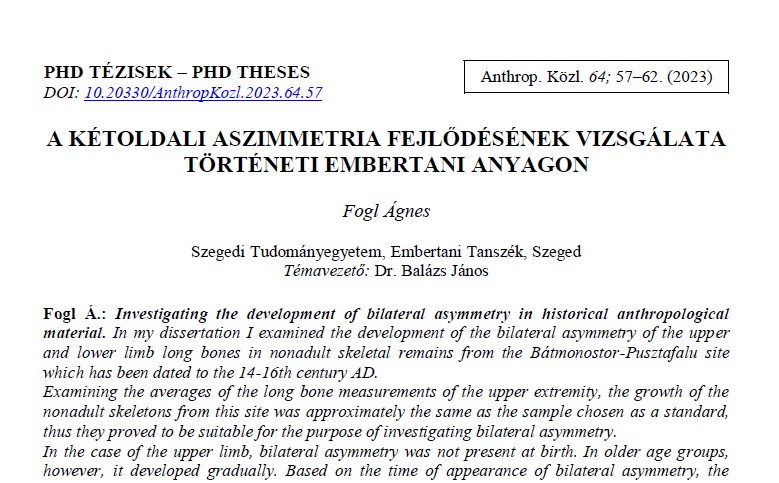A kétoldali aszimmetria fejlődésének vizsgálata történeti embertani anyagon
Absztrakt
In my dissertation I examined the development of the bilateral asymmetry of the upper and lower limb long bones in nonadult skeletal remains from the Bátmonostor-Pusztafalu site which has been dated to the 14-16th century AD.
Examining the averages of the long bone measurements of the upper extremity, the growth of the nonadult skeletons from this site was approximately the same as the sample chosen as a standard, thus they proved to be suitable for the purpose of investigating bilateral asymmetry.
In the case of the upper limb, bilateral asymmetry was not present at birth. In older age groups, however, it developed gradually. Based on the time of appearance of bilateral asymmetry, the development of its direction and the change in its magnitude with age I drew conclusions about the lifestyle of the examined children and their relationship with their environment. They probably already participated in farming and handicraft work at the age of 7-8, and the physical activities performed during this influenced the long bones of their upper limbs through the loading of the dominant arm, which was manifested in directional asymmetry shifting to the right.
The directional asymmetry of the femur showed a shift to the right side with age, and then to the left side in older age groups; thus crossed symmetry pattern could be observed. In the case of the tibia, I obtained partially opposite results to the femur. Shifting to the right in asymmetry was more common, but as age progressed, the differences between the right and left sides levelled off, just like in the case of the femur. As bipedal walking exerts an equal mechanical effect on the lower limb on both sides, asymmetry is less pronounced in the period of postnatal life from birth to adolescence.
The bioarchaeological study of limb bone bilateral asymmetry of nonadult skeletons gave me the opportunity to contribute to the biological reconstruction of the findings from the Bátmonostor-Pusztafalu cemetery.
Hivatkozások
Albert, A.M., Greene, D.L. (1999): Bilateral asymmetry in skeletal growth and maturation as an indicator of environmental stress. American Journal of Physical Anthropology, 110: 341–349. DOI: https://doi.org/10.1002/(SICI)1096-8644(199911)110:3<341::AID-AJPA6>3.0.CO;2-8
Aries, P. (1987): Gyermek, család, halál. Gondolat Kiadó, Budapest.
Bagnall K., Harris, P.F., Jones, P.R.M. (1982): A radiographic study of the longitudinal growth of primary ossification centers. Anatomical Record, 203: 293–299. DOI: https://doi.org/10.1002/ar.1092030211
Bareggi, R., Grill, V., Zweyer, M., Sandrucci, M.A., Narducci, P., Forabasco, A. (1994): The growth of long bones in human embryological and fetal upper limbs and its relationship to other developmental patterns. Anatomy and Embryology, 189: 19–24. DOI: https://doi.org/10.1007/BF00193126
Bigoni, L., Zaloudkova, M., Veleminska, J., Veleminsky, P., Seichert, V. (2005): The occurrence of directional and fluctuating limb asymmetry in a recently identified collection of human bones. Journal of the National Museum (Prague), Natural History Series, 174(1–4): 129–147.
Blackburn, A. (2011): Bilateral asymmetry of the humerus during growth and development. American Journal of Physical Anthropology, 145: 639–646. DOI: https://doi.org/10.1002/ajpa.21555
Farkas, L.Gy., Józsa, L., Bereczki, Zs. (2007): Examination of the human remains from the medieval cemetery of Bátmonostor-Pusztafalu. Acta Biologica Szegediensis, 51(2): 87–92.
Fazekas, L.Gy., Kósa, F. (1978): Forensic fetal osteology. Akadémia Kiadó, Budapest.
Fogl, Á., Pálfi, Gy., Molnár, E., Just, Zs., Balázs, J., Maák, I.E. (2022): Development of bilateral asymmetry of the upper limb in children from a medieval population in Central Europe, Hungary. Anthropologischer Anzeiger, in press. DOI: https://doi.org/10.1127/anthranz/2022/1478
Gabbard, C. (1992): Associations between hand and foot preference in 3- to 5-year-olds. Cortex, 28(3): 497–502. DOI: https://doi.org/10.1016/s0010-9452(13)80158-x
Gabbard, C., Hart, S. (1996): A question of foot dominance. Journal of General Psychology, 123(4): 289–296. DOI: https://doi.org/10.1080/00221309.1996.9921281
Hepper, P.G. (2013): The developmental origins of laterality: fetal handedness. Developmental Psychobiology, 55(6): 588–595. DOI: https://doi.org/10.1002/dev.21119
Martin, R., Saller, K. (1957): Lehrbuch der Anthropologie I–II. Fischer Verlag, Stuttgart, Germany.
McManus, I.C., Sik, G., Cole, D.R., Mellon, A.F., Wong, J., Kloss, J. (1988): The development of handedness in children. British Journal of Developmental Psychology, 6(3): 257–273. DOI: https://doi.org/10.1111/j.2044-835X.1988.tb01099.x
Mellor, M. (2014): Seeing the medieval child: evidence from household and craft. In: Hadley, D.M., Hemer, K.A. (Eds) Medieval Childhood: Archaeological Approaches Vol. 3. Oxbow Books, Oxford, 75–94. DOI: https://doi.org/10.2307/j.ctvh1drt6
Parma, V., Brasselet, R., Zoia, S., Bulgheroni, M., Castiello, U. (2017): The origin of human handedness and its role in pre-birth motor control. Scientific Reports, 7/16804. DOI: https://doi.org/10.1038/s41598-017-16827-y
Rebay-Salisbury, K., Pany-Kucera, D. (2020): Introduction. Children’s developmental stages from biological, anthropological and archaeological perspectives. In: Rebay-Salisbury, K., Pany-Kucera, D. (Eds) Ages and Abilities. Archeopress, Oxford, UK. pp. 1–9.
Scharoun, S.M., Bryden, P.J. (2014): Hand preference, performance abilities, and hand selection in children. Frontiers in Psychology, 5: 1–15. DOI: https://doi.org/10.3389/fpsyg.2014.00082
Schultz, A.H. (1926): Fetal growth of man and other primates. Quarterly Review of Biology, 1: 465–521.
Steele, J. (2000): Handedness in past human populations. Laterality, 5: 193–220. DOI: https://doi.org/10.1080/713754380
Stloukal, M., Hanáková, H. (1978): Die Länge der Längsknochen Altslawischer Bevölkerungen - Unter besonderer Berückichtigung von Wachstumsfragen. Homo, 29: 53–69.
Suskovics, Cs. (1996): Végtagcsontok méretbeli variációi néhány paleoantropológiai szérián. Savaria: A Vas Megyei Múzeumok értesítője. Pars Archaeologica, 22/3(1992–1995): 293–298.
Ubelaker, D.H. (1978): Human Skeletal Remains: Excavation, Analysis, Interpretation. Aldine Manuals on Archeology. Aldine Publishing Company, Chicago, USA. p. 116.
Waxenbaum, E.B., Sirak, K. (2016): Developmental patterns of bilateral asymmetry in Ancestral Puebloans. American Journal of Human Biology, 28: 421–430. DOI: https://doi.org/10.1002/ajhb.22804




